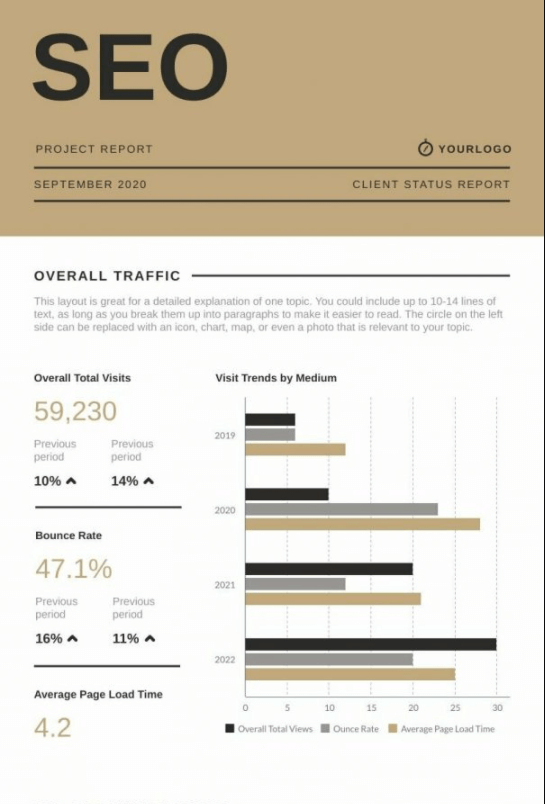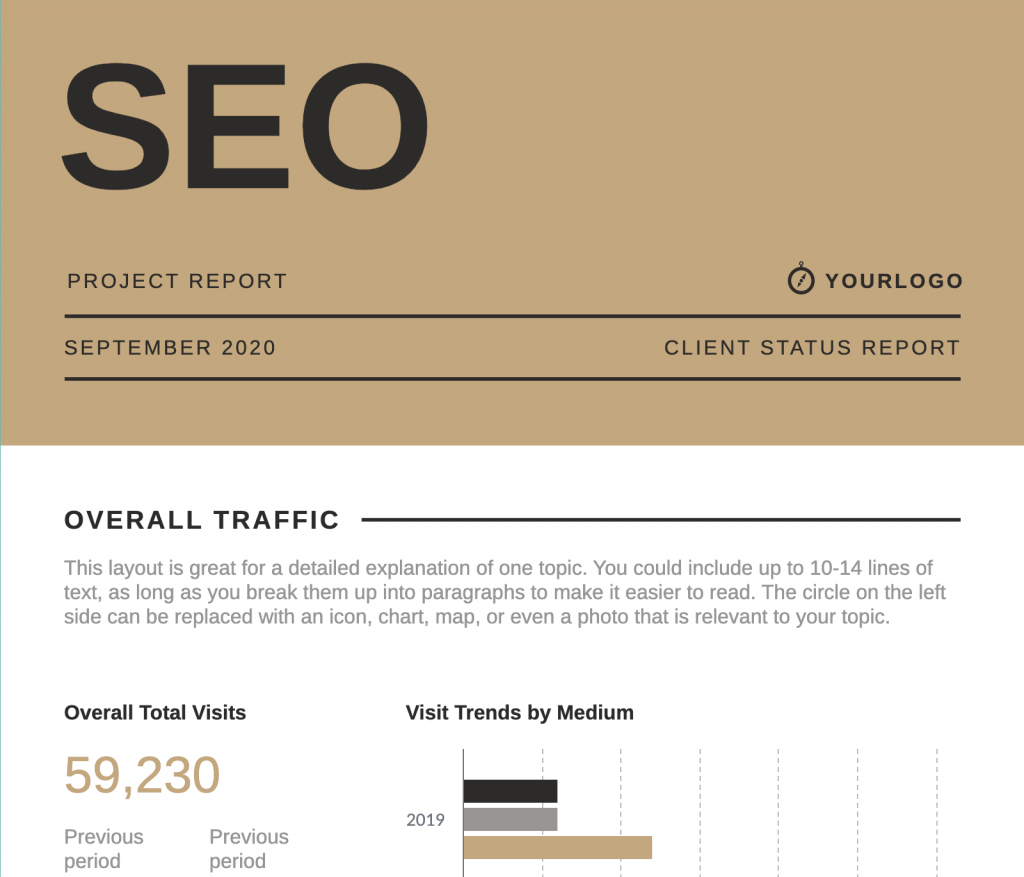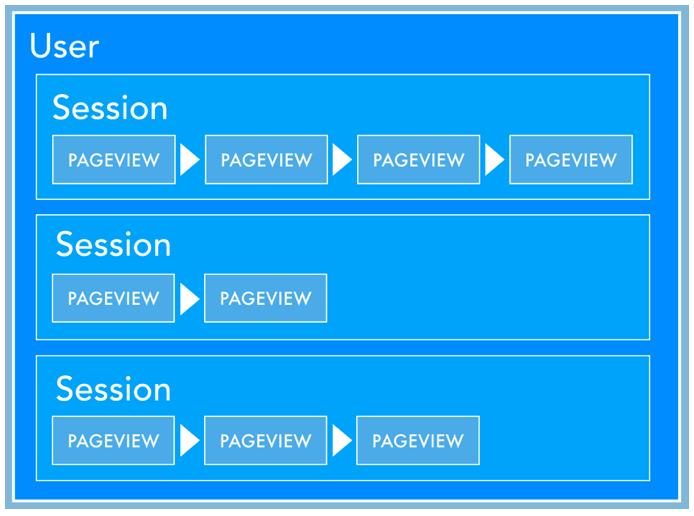Crafting perfect SEO reports for your clients gives you the power to influence your growth by fostering loyalty and word of mouth that lands you more opportunities and increases your revenue.
What is an SEO report?
An SEO report is an overview of how well your website performs in search engines and follows best practices. They’re often used to help clients parse information more clearly like:
- Understanding traffic
- Being able to see ranking changes
- See how many sales/leads are coming in
A solid SEO reporting template looks like this:

The perfect SEO report is similar to a business plan template, it’s there to keep you focused, help you get clear on your next actions, and create a structure for bringing new ideas into a concise document that you can present to people you might approach for help.
SEO reports are the secret to successful, happy, and sustainable client relationships.
This kind of reporting is essential and often time-consuming. So make sure you create reports your clients will actually read.
Why do you need to send monthly SEO reports?
Whether you are a freelancer or an SEO agency, your goal should always be to provide ongoing value and results.
So how do SEO reports help here?
Well the benefits of sending monthly reports allow you to:
- Position yourself as a valuable expert.
A lot of things aren’t within your control. That’s why data-backed insights are even more important to prove your worth as an expert who can control outcomes. - Show your client that you’re active.
Caring is expensive, but the agencies that put in the extra effort get rewarded with loyalty and word of mouth in the long run. - Reap the benefits of tracking.
Tracking allows you to have a more realistic picture of where you’re at. If you’re not making the right moves, you can seek out the necessary changes before falling behind. - Communicate your plan forward.
You’re hired for what you can do for your clients based on your expertise. Showing your clients a way forward is essential to your success.
In summary, when you are creating reports for your clients, you need to be doing one thing:
Showing the value you provide with your SEO service.
With that in mind, let’s take a look at what goes into a report (and how they communicate value to clients).
How to make an SEO report (that clients want to read)
A valuable SEO report is filled with metrics. The most common SEO tools are used for:
- Rank tracking
- Page analytics (users, sessions, page views)
- Competitor tracking
- Backlink tracking
You can use an endless sea of tools to collect metrics, but the most common are:
- Google Analytics
- Google Search Console
- Accuranker
- Ahrefs
And if your business is social, you’ll need to look at social media analytics tools. With these tools, you don’t need more data. You need a way to surface better, more actionable insights from the data you already have.
A good SEO report will pull all these elements into a single coherent story.
What to include in your SEO Reports:
- Organic traffic
- Engagement metrics
- Goals & Conversions
- Landing Pages & Content Pages
- Rankings, Keywords, and Search Visibility
- Link Metrics
- Commentary & Trends
Let’s explore each of these elements in more detail, focusing on why we include them for clients.
1) Organic Traffic
This is where tools like Google Analytics shine. Google Analytics uses three fundamental metrics to measure traffic: Users, sessions, and pageviews.
Users: A count of how many individuals visited.
Sessions: A count of how many times users visited.
Pageviews: A count of views on pages across your site.
Finding posts that didn’t get any traffic or are low-quality can lead to actionable items like content audits. The content audit gives you a chance to clean everything up and make your other pages better/higher-quality.
Why is it important for clients?
For most clients, getting more organic traffic is going to be one of the primary goals of hiring you to do SEO for them. One of the things that clients will want to know is this:
Is SEO working and where is my traffic coming from?
There is where we explain it to them, breaking down where their organic traffic is coming from, providing insights for how we can increase traffic going forward and even providing them with reasons behind any drops.
Remember: the point of SEO reporting is to provide clients with value. Making sure they understand what you are working on each month (and that you are being proactive) is a big win for everyone.
2) Engagement Metrics
Google Analytics is great for tracking engagement metrics like bounce rate, session duration, and pages per session.
Bounce Rate: A count of how many people closed your page without performing any action.
Average Session Duration: The average length of time users spend interacting with your site before closing.
Average Pages per Session: The average count of pages users visit before closing.
Google Analytics lets you quickly find these metrics without setting up anything else. These engagement metrics help you and your clients understand your impact and are critical to leverage content that attracts and retains users.
Why is it important for clients?
Content engagement metrics are essential for clients because they show how well your content strategy aligns with user interest. This engagement is often tied to overall profitability, as engaged users are more likely to be loyal, more likely to buy, and more likely to refer more customers like them.
3) Goals & Conversions
First, you need to determine what your most important goals are. For example, if you want to increase your business’s visibility and awareness, you would focus on traffic from new visitors. But if your goal is to increase customer loyalty, then you would focus on repeat purchases instead. Here are a few more definitions to get you going:
Conversion rate: A count of how many visitors completed the set goal out of the total number of visitors.
Conversion volume: A count of how many visitors completed the set goal.
Total Revenue: A count of total income earned.
Average Order Value: The average amount spent across each customer purchase.
You can’t improve what you don’t understand, so it’s essential to track what’s working and what’s not across campaigns. Your SEO report should connect conversions to your work.
Why is it important for clients?
Conversion goals are essential for clients because they help to measure your marketing performance and set benchmarks for improvement. You need to set well-defined and measurable goals for your clients and report on them to show progress.
4) Landing pages & Content pages
Landing pages and content pages are pages currently driving results. The landing page report in Google Analytics tells you how visitors arrive on your websites. We can use this data to see how our pages generate traffic.
Landing Page: The first page viewed in a users session.
Content Drilldown: Provides data on pages grouped by their sub-directory.
This data will help you structure your website for design and conversions. The pages that show up here are worth inspecting to uncover why they’re driving traffic.
Why is it important for clients?
Landing pages and content pages are essential for clients to understand the value of the current site architecture. It allows you to define customer journeys on your website that are most conducive to business success.
5) Rankings, Keywords, and Search Visibility
Rankings, keywords, and search visibility are often the most sought after achievements.
When you look at the same data and follow the same playbook as your competitors, you lose your competitive edge to gain them. Tracking your rankings allows you to evaluate your performance while developing your own insights to write your own strategies.
You can develop this edge by collecting and interpreting more data by using a SERP tracking tool.
Why is it important for clients?
Ranking, keywords, and search visibility are essential for clients to connect results to actions. When you can report higher organic traffic with the context of what search terms drove that traffic, your clients will continue your services.
6) Link metrics
Link metrics across your website help determine the importance of a link by weighing factors such as: Domain Strength: The ranking potential of a website.
Page Strength: Similar to domain strength, but focused on a specific page.
Anchor Text: The text used for the link.
Total New/Lost Domains: View new links to your domain and find lost links to recover.
What’s more, understanding how to get the most from your link equity helps make sure you maintain a good ROI and get more organic traffic.
You can use these link building metrics to track campaign success. Hopefully, you see a rise in total links and domains, alongside an increase in your website’s domain and page strength.
Why is it important for clients?
Link metrics are essential for clients to understand how different links provide different values. Some clients will even ask to use their minimum link metrics for link building as a useful marker to decide which links are valuable.
8) Commentary & Trends
This is where you should distinguish yourself. Like we said before, with all these tools, you don’t need more data. You need to surface better, more actionable insights from the data you already have.
Knowing your rank for various keywords doesn’t mean anything unless you have a process to change it. Identifying how your site responds to efforts better informs your current marketing plan and future investments.
But these insights are just the start. To actually move the needle, you have to do more than point out facts. You need to develop an assertion, to connect dots, interpret the situation, and give a position for what your client should do with this information to move forward.
Why is it important for clients?
Commentary and trends are essential for clients to execute before a space or tactic becomes crowded. There’s more content, networks, and products coming out than ever before. To not get lost in the noise, you need to find and show commentary and trends.
Putting it all together
All that data has to work visually to lead to execution.
Luckily, Piktochart lets you create beautiful reports easily with absolutely no design experience. The SEO Project Report template even gives you everything you need to get started now.

Summary
SEO reports give an overview to help your clients see progress towards their goals and position you as the person to get them there.
A good SEO report includes data and insights that support your developed position on how to move forward. Put all that into our SEO Project Report, and you’ll make the right moves to gain loyalty, word of mouth, and distinguish yourself as a valuable expert.
About the author:
Adam Steele is the Founder and COO at Loganix, an SEO fulfilment partner for agencies and marketers. We build easy to use SEO services that help businesses scale. If you liked this article, please check out our SEO guides and templates on the blog.






